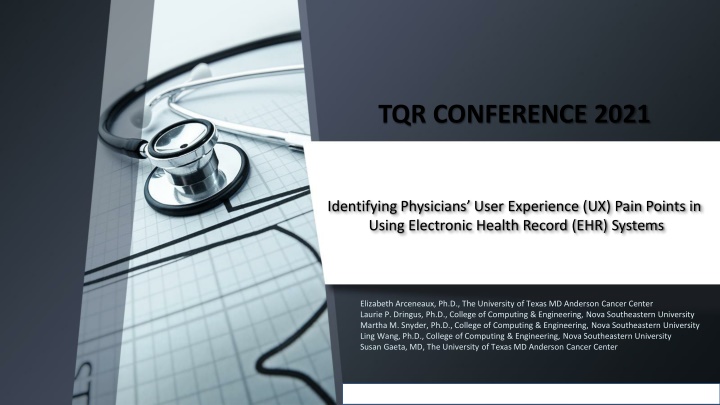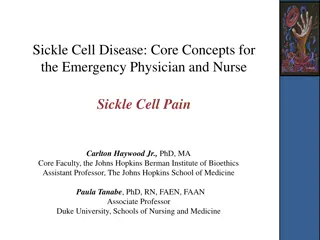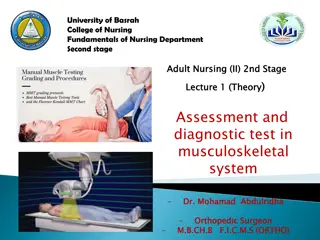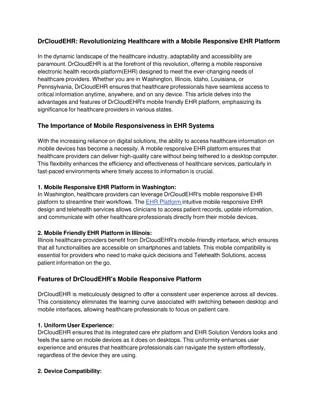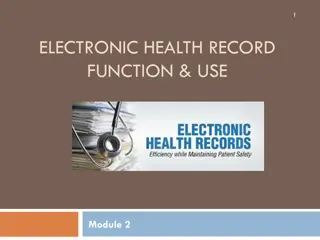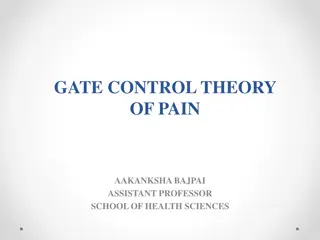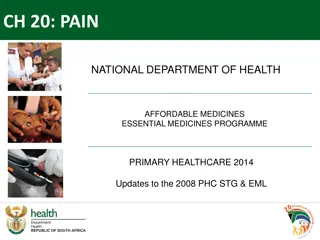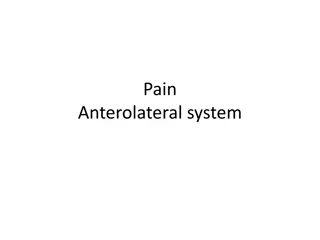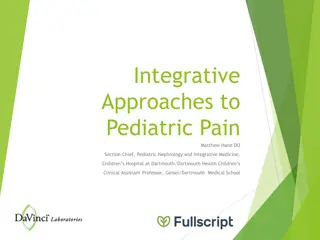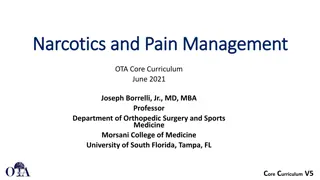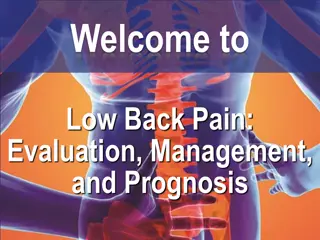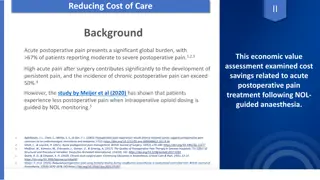Physicians' User Experience Pain Points in EHR Systems
Electronic Health Record (EHR) systems, while useful, present challenges for physicians. This study delves into understanding the lived experiences of physicians using EHR systems, focusing on the UX pain points they encounter. Research questions explore how physicians perform tasks, experience system functions, and identify system shortcomings. The literature review highlights the usability, task demands, task difficulty, and user experience aspects pertinent to EHR system use by physicians.
Download Presentation

Please find below an Image/Link to download the presentation.
The content on the website is provided AS IS for your information and personal use only. It may not be sold, licensed, or shared on other websites without obtaining consent from the author.If you encounter any issues during the download, it is possible that the publisher has removed the file from their server.
You are allowed to download the files provided on this website for personal or commercial use, subject to the condition that they are used lawfully. All files are the property of their respective owners.
The content on the website is provided AS IS for your information and personal use only. It may not be sold, licensed, or shared on other websites without obtaining consent from the author.
E N D
Presentation Transcript
TQR CONFERENCE 2021 Identifying Physicians User Experience (UX) Pain Points in Using Electronic Health Record (EHR) Systems Elizabeth Arceneaux, Ph.D., The University of Texas MD Anderson Cancer Center Laurie P. Dringus, Ph.D., College of Computing & Engineering, Nova Southeastern University Martha M. Snyder, Ph.D., College of Computing & Engineering, Nova Southeastern University Ling Wang, Ph.D., College of Computing & Engineering, Nova Southeastern University Susan Gaeta, MD, The University of Texas MD Anderson Cancer Center
Agenda Study Overview Methodology Data Analysis & Findings Conclusions
The Problem Although Electronic Health Record (EHR) systems appear to be useful, studies have suggested persistent user interface design problems that may hinder physician productivity (Kroth et al., 2019). Physician users have frequently reported that system workflows are inefficient and do not map to their clinical process needs (Denton et al., 2018; Meigs & Solomon, 2016). Researchers have examined EHR adaptation and user interface design (Mazur, Mosaly, Moore, & Marks, 2019; Pfaff et al., 2020). Research is limited on understanding the lived experiences of physicians who use the system.
Research Questions Grand Tour Question: What are the UX pain points that physicians describe as their lived experiences with EHR system use? Sub Questions: 1. How do physician users describe how they perform routine clinical tasks in the system? 2. How do physician users describe how they experience system task functions that are difficult to perform? 3. How do physician users describe aspects of the system that do not meet the needs of physician users?
Literature Review USABILITY TASK DEMAND & TASK DIFFICULTY Qualitative and mixed studies have explored task demands and task difficulty and the way it impacts a clinician s performance (Edwards, Gabets, Mercer, & Bienert, 2017; Sultanum, Brudno, Wigdor, & Chevalier, 2018). Navigation and workflow patterns have been investigated through the use of simulated scenarios and usability evaluations (Coleman et al., 2020; Salwei et al., 2019). Salwei et al. s findings suggest future research on workflow analysis throughout the human centered design process and a user s day-to- day workflow. Sultanum et al. (2018) contended that there are time constraints as physicians attempt to perform tasks such as reviewing an overview of the patient s medical history, consulting with the patient, and consolidating documentation. USER EXPERIENCE (UX) The user experience is context and dependent driven; indicative of a user s internal expectations, system features, and the setting where the user s interaction occurs (Feng & Wei, 2019). Pine and Chen (2020) found that paper charting has not completely disappeared although EHR systems provide note intensive tasks and clinical decision tasks. Other UX studies (Chen, Pourchon, Gaumont, De Grandpr , & L ger 2019) have placed attention on the negative relationship between an application s features and the needs of a user, known as a user s pain points.
Research Method Interpretative Phenomenological Analysis (IPA) IPA has been a commonly used tool in healthcare to observe a variety of topics from the clinical user perspective (Chen et al., 2018). The IPA approach allowed the researcher to create an analytic interpretation of the participant s experience and go beyond the participant s sense-making and understanding (Smith, Flowers, & Larkin, 2009). Although Kellogg, Fairbanks, and Ratwani (2017) indicated that cognitive-based design is currently not integrated well with EHR commercial designs, there was room for the researcher to examine healthcare and the essences of the user experience.
Participant Selection & Recruitment Out of fifteen invitations, eight clinicians agreed to participate. Two participants were pilot participants Attending physicians who actively practice medicine in the emergency department (ED) were chosen for this study. Sample selection was obtained through purposeful and snowball sampling techniques. The Emergency Medicine Leadership group were asked for referrals: Physician Champions EHR user for at least one year
Data Collection Semi-structured Interviews Interview Guide Open-ended questions were asked to allow a conversational dialogue. The Interview guide consisted of eight questions to help frame the conversation. Interviews occurred in the physician s office or conference room on site. It was not practical to interview physicians while they were actively working. Participants were able to give a deep and contextual account of their user experience. Users were also asked to log into EHR shadow environment to perform a user walkthrough during the interview process. The user walkthrough allowed the researcher to observe the user s workflow and help gain implicit knowledge about their lived experiences. Interruptions in the emergency department (ED) could cause serious patient safety consequences (Fong, Hettinger, & Ratwani, 2017).
Data Analysis Transcription & Initial Coding Verbatim record of interview data was recorded and transcribed by third party transcription company. Participants were asked to provide a validity check to verify the accuracy of the transcript (Groenewald, 2014). The researcher became immersed in the data through reading and re-reading of the transcript and listening to audio concurrently. Initial thoughts were written on a clean version of transcript. Researcher performed an analytic dialogue line by line with words, phrases, and sentences.
Data Analysis Development of Themes & Connections Transcript files were loaded into NVivo Software. Organization of data and mapping of interrelations of data through use of annotations (see Figure 1). Cross case analysis was performed with the initial notes on each transcript and files loaded into NVivo. Figure 1. Example of Annotations in NVivo Software
Data Analysis Patterns The numeration method as defined by Smith et al. (2009) was followed to identify patterns in the data by examining the number of times a theme was supported. NVivo s word frequency query feature allowed the researcher to locate frequently used words or concepts. Abstraction was used to help identify the connections and patterns among emergent themes and helped organize the data into larger units (Creswell & Poth, 2018). Potential themes were compiled in chronological order and printed out to help maintain focus and identify connections across cases (See Figure 2). The table further allowed researcher to review nested themes and super-ordinate themes for each participant (Smith et al., 2009). Figure 2. Example of Identifying Patterns Across Cases
Findings Emergent Themes 1. Accessibility 6. Lack of Customization 2. Application Failure 7. Lack of Standard Documentation 3. Content Overload 8. Patient Handoff 4. Coping with Efficiency 9. Readable Documentation 5. ED Capacity 10. Slow System Response
Development of Super Ordinate Themes Super Ordinate Themes 1. Historical Chart Review Patterns Emergent Themes Ability to Locate Relevant Notes Ability to Locate Lab Results Ability to Locate Home Meds. Inadequate Filters Inconsistent Documentation Content Overload Accessibility Readable Documentation Lack of Customization 2. Note Documentation Inconsistent Documentation Inadequate Note Template Lack of Customization Mobile Charting Dictation Readable Documentation Lack of Standard Documentation Coping with Efficiency Patient Handoff 3. Patient Throughput Barriers 4. Poor System Performance 5. Difficult Order Entry Hard to Find Lab Orders Patient Discharge Lack of Standard Documentation Ability to Locate Home Meds. Inconsistent Documentation Inadequate Note Template Skewed Metrics Coping with Efficiency Patient Admission ED Capacity Patient Handoff Ability to place orders Ability to write notes Coping with Efficiency Accessibility Skewed Metrics Slow System Response Application Failure Ability to place orders Hard to Find Med. Orders Lack of Customization Lack of Standard Terminology Slow System Response Coping with Efficiency Accessibility
Super-Ordinate Themes Inadequate Note Documentation Historical Chart Review Patient Difficult Poor Order Entry Throughput Barriers System Performance We have to put in the admission orders, which is not normal for an emergency department. Um, so sitting down doing admission orders, then instead of picking up a phone and talking directly to somebody then you have to write an email and um, make sure that we send it to every appropriate attending Participant P3 ...note documentation is tedious...in many other countries without the focus on documentation for insurance purposes, there's no need for all of this. Okay, so like in the far east or even Japan, their medical records are very brief. It's for the purpose of the physician making decisions. It's not for the purpose of the insurance - Participant P7 The system freezes and of course after working ten hours, eight or nine hours, it goes down. And it used to make me crazy 'cause I lose notes . But it is really hard, oh my God you'll be in the middle of a note or you're trying to put an order, now that's the worst, when you're in the middle of your orders and it can't do any more, then you have to restart Participant P6
Implications This study has implications for information technology (IT) system designers, healthcare administrators, physician end users. Findings allow future research opportunities for designers to re-evaluate amount of information displayed to physician end users as they review historical chart information. There are also new possibilities for designers to find innovative ways to reduce click burden as physicians review charts, transcribe progress notes, and other tasks.
Recommendations System designers should review findings and identify types of users who fit the profile. Focus groups are recommended to identify systemic and workflow issues that hinder safe and efficient patient care. Healthcare leaders and administrators should examine patient admissions by emergency room (ER) physicians. Findings reveal that it is difficult for these providers to manage patient throughput in the ER, be fully responsible for admissions, and maintain clinical documentation in the system.
Future Research This study provides future research opportunities for researchers to investigate the experiences of individuals who work in a different specialized area of the hospital, such as the intensive care unit (ICU). Research should focus on the different tools these professionals use and their perspectives about how they manage the difficulty of system tasks and demands. Additional research opportunities exist for EHR usability; specific tasks that participants described and how the users can become more efficient.
References Page 1 of 3 Chen, H., Butler, E., Guo, Y., George Jr, T., Modave, F., Gurka, M., & Bian, J. (2018). Facilitation or hindrance: physicians perception on best practice alerts (BPA) usage in an electronic health record System. Health Communication, 1-7. Chen, S. L., Pourchon, R., Gaumont, Y., De Grandpr , D., & L ger, P. M. (2019, September). User Test: How Many Users Are Needed to Find the Psychophysiological Pain Points in a Journey Map?. In Human Interaction and Emerging Technologies: Proceedings of the 1st International Conference on Human Interaction and Emerging Technologies (IHIET 2019), August 22-24, 2019, Nice, France (Vol. 1018, p. 136). Springer. Coleman, C., Gotz, D., Eaker, S., James, E., Bice, T., Carson, S., & Khairat, S. (2020). Analyzing EHR navigation patterns and digital workflows among physicians during ICU pre-rounds.Health Information Management Journal, 1833358320920589. Creswell, J. W., & Poth, C.N. (2018). Qualitative inquiry & research design choosing among five approaches. Thousand Oaks, California: Sage. Denton, C. A., Soni, H. C., Kannampallil, T. G., Serrichio, A., Shapiro, J. S., Traub, S. J., & Patel, V. L. (2018). Emergency physicians' perceived influence of EHR use on clinical workflow and performance metrics. Applied clinical informatics,9(3), 725. Edwards, T., Gabets, C., Mercer, J., & Bienert, N. (2017). Task demand variation in air traffic control: implications for workload, fatigue, and performance. In Advances in Human Aspects of Transportation (pp. 91-102). Springer International Publishing. Feng, L., & Wei, W. (2019). An empirical study on user experience evaluation and identification of critical UX issues. Sustainability, 11(8), 2432.
References Page 2 of 3 Fong, A., Hettinger, A. Z., & Ratwani, R. M. (2017, May). A predictive model of emergency physician task resumption following interruptions. In Proceedings of the 2017 CHI Conference on Human Factors in Computing Systems (pp. 2405-2410). ACM. Groenewald, T. (2004). A phenomenological research design illustrated. International Journal of Qualitative Methods, 3(1), 42-55. Kellogg, K. M., Fairbanks, R. J., & Ratwani, R. M. (2017). EHR Usability: get it right from the start. Biomedical Instrumentation & Technology, 51(3), 197-199. Kroth, P. J., Morioka-Douglas, N., Veres, S., Babbott, S., Poplau, S., Qeadan, F., ... & Linzer, M. (2019). Association of electronic health record design and use factors with clinician stress and burnout. JAMA network open, 2(8), e199609- e199609. Mazur, L. M., Mosaly, P. R., Moore, C., & Marks, L. (2019). Association of the usability of electronic health records with cognitive workload and performance levels among physicians. JAMA Network Open, 2(4), e191709-e191709. Meigs, S. L., & Solomon, M. (2016). Electronic health record use a bitter pill for many physicians. Perspectives in Health Information Management,13(Winter). Mosaly, P. R., Mazur, L. M., Yu, F., Guo, H., Derek, M., Laidlaw, D. H., & Mostafa, J. (2017). Relating task demand, mental effort and task difficulty with physicians' performance during interactions with electronic health records (EHRs). International Journal of Human Computer Interaction, 1-9.
References Page 3 of 3 Pfaff, M. S., Eris, O., Weir, C., Anganes, A., Crotty, T., Rahman, M., ... & Nebeker, J. R. (2020). Analysis of the cognitive demands of electronic health record use. Journal of Biomedical Informatics, 113, 103633 Pine, K. H., & Chen, Y. (2020, April). Right Information, Right Time, Right Place: Physical Alignment and Misalignment in Healthcare Practice. In Proceedings of the 2020 CHI Conference on Human Factors in Computing Systems (pp. 1-12). Salwei, M. E., Carayon, P., Hoonakker, P., Hundt, A. S., Novak, C., Wang, Y., & Patterson, B. (2019, November). Assessing workflow of emergency physicians in the use of clinical decision support. In Proceedings of the Human Factors and Ergonomics Society Annual Meeting (Vol. 63, No. 1, pp. 772-776). Sage CA: Los Angeles, CA: SAGE Publications. Smith, J. A., Flowers, P., & Larkin, M. (2009). Interpretive phenomenological analysis: Theory, method and research. Los Angeles, CA: Sage. Sultanum, N., Brudno, M., Wigdor, D., & Chevalier, F. (2018, April). More text please! understanding and supporting the use of visualization for clinical text overview. In Proceedings of the 2018 CHI Conference on Human Factors in Computing Systems (p. 422). ACM. .
